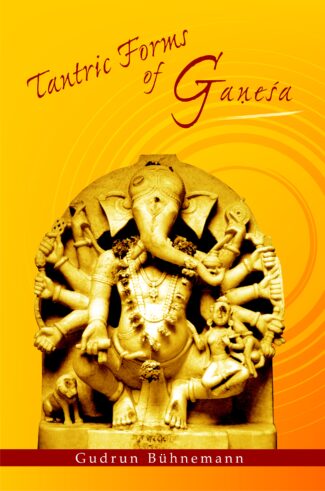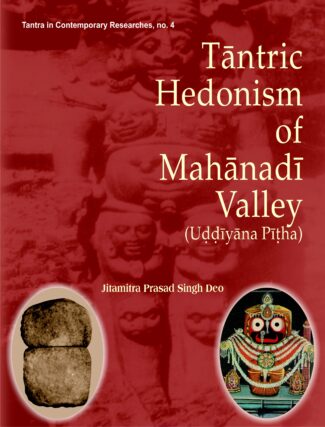Showing 11–17 of 17 results

There may be many publications dealing with Ganesa, but only a few take original Sanskrit texts into consideration. Since the Tantric aspects of the deity have been studied too little, this book details fourteen forms of Ganesa as described in the Vidyarnavatantra.
Although the number of publications dealing with Ganesha is not insignificant, few take original Sanskrit texts into consideration. The Tantric aspects of the deity have certainly been studied too little. This book contributes to our knowledge of this less familiar side of Ganesha. It describes his forms according to the Vidyarnavatantra, a large compilation on mantrashastra attributed to Vidyaranya Yati and compiled around the seventeenth century. This text gives the iconographic peculiarities, mantras, and yantras of fourteen forms of Ganesha as well as instructions for the ritual application of the mantras.

It is the study of the yogic developments in the Mahanadi Valley which evolved erotic mysticism and examines the evolution of Tantric Cults. With numerous illustrations, it emphasises on the art and architectural expressions of tantric belief. Furthermore the concept of sex to super-consciousness has been described in detail.
This is a brilliant cultural-anthropological study exploring those hedonistic aspects of the pan-Indian heritage which, represented by centuries of the non-Vedic, Tantric tradition, affirm that the pleasurable, especially the sexually pleasurable, is natural as a means to achieve the highest mystical experience. Himself a Tantric initiate, Prem Saran offers a compelling, sympathetic analysis of Tantrism, its place in the Bengali and Assamese cultures, and its pervasiveness in pan-Indian thought and ritual generally. Prem Sarans is also a cultural critique of modern Indian values and life-ways. In addition, it is an exercise in methodology, employing certain anthropological tools and concepts like “Cultural Debate”, “Cultural Criticism”, “Hindu Renaissance” and “Pizza-effect” the last three having been developed by the late Professor Agehananda Bharati whom the author acknowledges as a “constant source of encouragement” during the last decade. Though tantra is juxtaposed to Vedic traditions as a heterodox, life-affirming tradition, which is both ancient and basic to Hindu interpretations of being, its hedonistic contents have been purposely neglected or suppressed, partly because of the continuing hold of Victorian morality (imbibed from the British missionaries and colonial rulers), and partly because the erotic route to mystical achievement has always been a secret, minority path. Tantra: Hedonism in Indian Culture will, therefore, fill an existing lacuna in the cultural-anthropology of South Asia. The book carries a Foreword by the distinguished anthropologist, Professor Mattison Mines of the University of California, Santa Barbara, USA.

This volume combines the study of primary sources on Shakta Tantra with the investigation of living interpretations of these sources by contemporary Nepalese practitioners. It is twenty-year analysis on a specific Tantric tradition Shri Vidya a specific deity Tripurasundari a specific text Nityashodashikarnava and a specific set of initiates within a specific locale the Kathmandu Valley.
In this groundbreaking study on Sarvamnaya Shakta Tantra in Nepal, Jeffrey S. Lidke combines the study of primary sources with the investigation of living interpretations of these sources by contemporary Nepalese practitioners. Lidke focuses his twenty-year analysis on a specific Tantric tradition Shri Vidya a specific deity Tripurasundari a specific text Nityashodashikarnava and a specific set of initiates within a specific locale the Kathmandu Valley.
This emphasis on specificity enables the author to contextualize his study within the unique Nepalese historical and sociocultural context, and thereby to represent Sarvamnaya Shakta Tantra not as a static, universal ism present in a single form throughout the subcontinent, but as a dynamic place-specific tradition reflecting the nuanced ways that peoples and institutions shape their religious traditions according to the power negotiations that arise in Tantric worlds in which individuals imagine they can be like the gods they worship.
The central symbol that drives these negotiations in Nepal is the mandala, a pan-Tantric instrument of worship by which Tantric practitioners be they kings, commoners, artisans or warriors navigate, imagine and identify with the territories in which they live and strive to obtain their mundane and spiritual aims.
The mandalas ubiquitous presence is found not just overtly in city designs, temple architecture and a seemingly infinite array of artistic representations (including sculpture, painting, music and dance) but also covertly in the secret rituals and meditation practices of initiates at all levels of Nepalese society, ranging from lower caste girls to the former kings of Nepal.
The Kalacakra Tantra was the last major Tantrik text written in India before the decline of Buddhism. The book has left indelible influence over different regions of Asia in last thousand years of its journey. Apart from the Vimalprabha commentary composed during the mid-11th century, there is no verse by verse commentary available to the general reader. Kumar has attempted translation of the full text from Sanskrit original and has also contributed a new detailed commentary. This book locates mysterious Sambhala and Oddiyana. The book further delves into the chronology of legendary Kalki kings.

The volume studies comprehensively the theory and practice of Tibetan Buddhism: its historical, religious and cultural evolution, its various deities and their symbolism, its basic philosophy and sadhana and the intricacies of the religious experience it involves. It has numerous illustrations and references to original works.
Tibetan Buddhism has held a place of its own in the Buddhist tradition, having preserved and evolved the religious culture of the Vajrayana, the final phase of Buddhism in India. Within that, the Tibetan Tantric belief has a unique significance and it has made a memorable contribution to the literature on Tibetan Buddhism. This authoritative work deals with the theory and practice of Tibetan Buddhism in a comprehensive manner. It presents a study of Tibetan Tantricism beginning with an account of the historical, religious and cultural evolution of Tibetan Buddhism and delving into the intricacies of practice of the religion. Dr. Krishna Ghosh discusses the many deities of the tradition as representing a wide range of religious experience from the primitive to the sublime. She lays bare the complex vision of Tibetan Tantric Buddhist philosophy and sadhana, clearing it of the obscurantism associated with the belief system for long. The work abounds in illustrations line drawings and photographs and has numerous references to original works by Tibetan and other scholars. The book is written in an easy-accessible style to allow a broad range of readers to familiarise themselves with Tibetan Tantric Buddhism. Its penetrating insights into the subject would make it an invaluable work for scholars and practitioners of the tradition.

Dr. T. N. Mishra explores the moral and philosophical meanings and significance of yoga and studies the philosophies and practices that bear reference to it. Abounding in illustration, notes and references to scholarly treatises, it explains yoga psychology, its classification, techniques and stages and practice and concentrating on Yoga-tantra and its impact on Indian art and architecture.
The word yoga and the various concepts associated with it are being interpreted and understood with great interest the world over especially in recent years. This work by a noted research scholar, Dr. T. N. Mishra explores the meanings of the word yoga and its moral and philosophical annotations, and conducts an intensive study of the philosophies and practices that bear reference to it. A thorough research, Yoga-Tantra and Sensuousness in Art goes into the theoretical foundations of Yoga, tracing its roots to the sacred scriptures and explaining the goal of Yoga, the discipline it involves, Yoga psychology, its techniques and stages, and classification and practice of Yoga as Mantra-Yoga, Laya-Yoga, Hatha-Yoga and Raja-Yoga. It comprehensively examines the aim and philosophy of Yoga-Tantra and the way to awaken the kundalini through the cakras practising Yoga-Tantra. It makes a detailed analysis of the Yoga-sadhana of the Natha siddhas (the ulta-sadhana) and Yoga-sadhana as found in Vaisnava and Buddhist Sahajiya. Citing interesting examples, it importantly deals with Yoga and Tantra as reflected in Indian art: the impact of the philosophy of Yoga-Tantra with its subtle sensuality on Indian secular and religious architecture and sculpture. Abounding in illustrations and extensive in notes and references to ancient scholarly treatises and exponents of Yoga and to modern researches on the subject, the book will interest all scholars of Indian art, philosophy and spirituality and appeal to general readers on Yoga as well.

This book is a journey in search of these mysterious figures who nestle in the shadow of the Goddess. A journey which unfolds in the frontier zones of Indian tradition, constantly hanging in the balance between Tantric rituals, sacrifices and subtle knowledge.
The Yoginis are awful expressions of the divine in feminine form of which evidence is found in Tantric contexts in both the Hindu and Vajrayana Buddhist traditions. Endowed with a multitude of aspects and functions, they may take the form of women or witches devoted to obscure rituals, of primordial forces linked with illness, poisoning and possession, of subtle beings present in supporting one for meditation like yantra and mantra, or of genuine gods who frighten and fascinate. Gathering in circles in the depths of the forest or in cremation grounds, the Yoginis engender powers and secret knowledge, granted to those who evoke them through practices which may be extreme. Ultimately the Yoginis keep company with death, offering to the initiates who surrender to their embrace the prospect of liberation beyond the glittering world of illusion.
This book is a journey in search of these mysterious figures who nestle in the shadow of the Goddess. A journey which unfolds in the frontier zones of Indian tradition, constantly hanging in the balance between Tantric rituals, sacrifices and subtle knowledge a perilous quest which is the heritage of all traditional searches.
This volume written in elegant, fluent and colourful prose should entice the interest of all those associated with the Tantric practices, especially that of Saptamatrikas, ten Mahavidyas, Dakini and Nitya.
| There are no products |